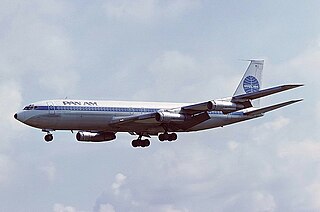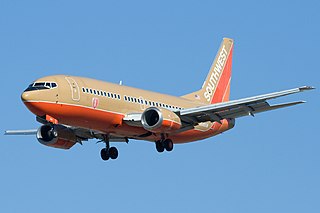
The Boeing 747 is a long-range wide-body airliner designed and manufactured by Boeing Commercial Airplanes in the United States between 1968 and 2023. After the introduction of the 707 in October 1958, Pan Am wanted a jet 2+1⁄2 times its size, to reduce its seat cost by 30%. In 1965, Joe Sutter left the 737 development program to design the 747. In April 1966, Pan Am ordered 25 Boeing 747-100 aircraft, and in late 1966, Pratt & Whitney agreed to develop the JT9D engine, a high-bypass turbofan. On September 30, 1968, the first 747 was rolled out of the custom-built Everett Plant, the world's largest building by volume. The 747's first flight took place on February 9, 1969, and the 747 was certified in December of that year. It entered service with Pan Am on January 22, 1970. The 747 was the first airplane called a "Jumbo Jet" as the first wide-body airliner.

The Boeing 707 is an early American long-range narrow-body airliner, the first jetliner developed and produced by Boeing Commercial Airplanes. Developed from the Boeing 367-80 prototype first flown in 1954, the initial 707-120 first flew on December 20, 1957. Pan Am began regular 707 service on October 26, 1958. With versions produced until 1979, the 707 is a swept wing quadjet with podded engines. Its larger fuselage cross-section allowed six-abreast economy seating, retained in the later 720, 727, 737, and 757 models.
Deutsche Lufthansa AG, or simply Lufthansa, is the flag carrier of Germany. When combined with its subsidiaries, it ranks second in Europe by passengers carried, as well as largest in Europe and fourth largest in the world by revenue. Lufthansa is also one of the five founding members of Star Alliance, which is the world's largest airline alliance, formed in 1997. Lufthansa was founded in 1953 and commenced operations in April 1955.

The Boeing 737 is an American narrow-body airliner produced by Boeing at its Renton factory in Washington. Developed to supplement the Boeing 727 on short and thin routes, the twinjet retained the 707 fuselage width and six abreast seating but with two underwing Pratt & Whitney JT8D low-bypass turbofan engines. Envisioned in 1964, the initial 737-100 made its first flight in April 1967 and entered service in February 1968 with Lufthansa. The lengthened 737-200 entered service in April 1968, and evolved through four generations, offering several variants for 85 to 215 passengers.

The Airbus A310 is a wide-body aircraft, designed and manufactured by Airbus Industrie GIE, then a consortium of European aerospace manufacturers. Airbus had identified a demand for an aircraft smaller than the A300, the first twin-jet wide-body. On 7 July 1978, the A310 was launched with orders from Swissair and Lufthansa. On 3 April 1982, the first prototype conducted its maiden flight, and the A310 received its type certificate on 11 March 1983.

The Airbus A340 is a long-range, wide-body passenger airliner that was developed and produced by Airbus. In the mid-1970s, Airbus conceived several derivatives of the A300, its first airliner, and developed the A340 quadjet in parallel with the A330 twinjet. In June 1987, Airbus launched both designs with their first orders and the A340-300 took its maiden flight on 25 October 1991. It was certified along with the A340-200 on 22 December 1992 and both versions entered service in March 1993 with launch customers Lufthansa and Air France. The larger A340-500/600 were launched on 8 December 1997; the A340-600 flew for the first time on 23 April 2001 and entered service on 1 August 2002.

A model airport is a scale model of an airport. While airport models have been around, in a way, since airfields were open to the public, early model airports were basically restricted to public showcases about the airport and its surroundings to the public; these were usually located inside the airport themselves.
Luxair, legally Luxair S.A., Société Luxembourgeoise de Navigation Aérienne, is a flag carrier of Luxembourg with its headquarters in Munsbach, Luxembourg, and hub at Luxembourg Airport. It operates scheduled services to destinations in Europe, North Africa, the Mediterranean and the Middle East with additional charter and seasonal services. It is Luxembourg's only passenger-carrying airline offering regular, non-charter service.

The McDonnell Douglas MD-11 is an American tri-jet wide-body airliner manufactured by American manufacturer McDonnell Douglas (MDC) and later by Boeing. Following DC-10 development studies, the MD-11 program was launched on December 30, 1986. Assembly of the first prototype began on March 9, 1988. Its maiden flight occurred on January 10, 1990, and it achieved Federal Aviation Administration (FAA) certification on November 8. The first delivery was to Finnair on December 7 and it entered service on December 20, 1990.
LATAM Airlines Chile, formerly known as LAN Chile and LAN Airlines, is a Chilean multinational airline based in Santiago and one of the founding companies of the LATAM Airlines Group, the largest airline holding company in Latin America. Its main hubs are in the Arturo Merino Benítez International Airport in Santiago, Guarulhos International Airport in São Paulo and Jorge Chávez International Airport in Lima, with secondary hubs in Bogotá, Quito, Guayaquil and Asunción.

Herpa Wings is a brand that identifies the die-cast model aircraft line of German company Herpa. The collection includes 250 airlines under 17 different aircraft manufacturers in 1:200 scale. The mainstay of Herpa Wings is in the 1:500 scale, while model airliners are also produced in the 1:400, 1:200, 1:1000, and 1:160 scales. Herpa Wings model airliners may also be used in conjunction with Herpa's SCENIX series, which includes model diorama airports and airport accessories.
Cirrus Airlines Luftfahrtgesellschaft mbH was a German regional airline with its head office in Hallbergmoos and its maintenance facilities at Saarbrücken Airport. It operated both charter and scheduled flights, the latter on behalf of Lufthansa, Swiss International Air Lines and Air Moldova. Its main bases and hubs were Saarbrücken Airport and Mannheim City Airport. The company slogan was connecting business.
Lufthansa Cargo AG is a German cargo airline and a wholly owned subsidiary of Lufthansa. It operates worldwide air freight and logistics services and is headquartered at Frankfurt Airport, the main hub of Lufthansa. Besides operating dedicated cargo planes, the company also has access to cargo capacities of 350 passenger aircraft of the Lufthansa Group.

A die-cast toy is a toy or a collectible model produced by using the die-casting method of putting molten lead, zinc alloy or plastic in a mold to produce a particular shape. Such toys are made of metal, with plastic, rubber, glass, or other machined metal parts. Wholly plastic toys are made by a similar process of injection molding, but the two methods are distinct because of the properties of the materials.

Combi aircraft in commercial aviation are aircraft that can be used to carry either passengers as an airliner, or cargo as a freighter, and may have a partition in the aircraft cabin to allow both uses at the same time in a mixed passenger/freight combination. The name combi comes from the word combination. The concept originated in railroading with the combine car, a passenger car that contains a separate compartment for mail or baggage.
Austrian Airlines AG, often shortened to Austrian or AUA, is the flag carrier of Austria and a subsidiary of Lufthansa, the flag carrier of Germany. The airline is headquartered on the grounds of Vienna International Airport in Schwechat where it also maintains its hub. As of July 2016, the airline flew to six domestic and more than 120 international year-round and seasonal destinations in 55 countries and is a member of the Star Alliance.

The Hasegawa Corporation is a Japanese company that manufactures plastic model kits of a variety of vehicles, including aircraft, cars, ships, military vehicles, model armor, model space craft, and science fiction kits.

The Boeing 737 Classic is a series of narrow-body airliners produced by Boeing Commercial Airplanes, the second generation of the Boeing 737 series of aircraft. Development began in 1979 and the first variant, the 737-300, first flew in February 1984 and entered service that December. The stretched 737-400 first flew in February 1988 and entered service later that year. The shortest variant, the 737-500, first flew in June 1989 and entered service in 1990.
A business class airline is an airline concept which emerged during the mid-first decade of the 21st century a number of airlines that operated all-business class service.

1:500 scale is a scale mainly used by Europeans for pre-finished die-cast airliner models, such as German manufacturer Herpa. This scale is also used by Japanese model kit manufacturer Bandai, Nichimo Company Ltd. and Fujimi Mokei for ship and science fiction model kits.














